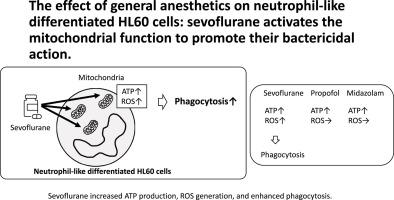The effect of general anesthetics on neutrophil-like differentiated HL60 cells: sevoflurane activates the mitochondrial function to promote their bactericidal action
IF 2.2
Q3 BIOCHEMISTRY & MOLECULAR BIOLOGY
引用次数: 0
Abstract
Background
Recent research has suggested that general anesthetics may affect the immune system, but it is unclear how they affect the mitochondria of neutrophils. The effects of general anesthetics on neutrophil-like differentiated HL60 cells mitochondrial function and their production of reactive oxygen species (ROS) were examined in this study.
Methods
HL60 cells were differentiated into neutrophil-like cells by treating them with 1 μM all-trans-retinoic acid for 4 days. The differentiated HL60 cells were exposed to propofol (4 μg ml−1), midazolam (0.5 μg ml−1), or sevoflurane (3 %) for 1 h or 5 h. Following the exposure to the anesthetics, we analyzed the production of ROS, bactericidal effects, cell viability, and apoptosis of the neutrophil-like differentiated HL60 cells. We also investigated the effects of these anesthetics on mitochondrial morphology and function of the neutrophil-like differentiated HL60 cells.
Results
Administration of propofol or midazolam activated neutrophil-like differentiated HL60 cells mitochondrial respiration and increased ATP production (P < 0.05). However, there was no significant change in production of ROS or cell death. Exposure to sevoflurane activated mitochondrial respiration, ATP production (P < 0.05) and ROS production (P < 0.05). Additionally, exposure to sevoflurane led to a significant increase in phagocytosis. Filamentous mitochondria appeared after treatment with propofol, midazolam, and sevoflurane, while fragmented and filamentous mitochondria were seen in untreated neutrophil-like differentiated HL60 cells.
Conclusion
We investigated the effects of three anesthetics on the mitochondrial and bactericidal functions of differentiated HL60 cells. Our results indicate that sevoflurane activates mitochondrial function in differentiated HL60 cells, promotes the production of reactive oxygen species, and enhances bactericidal activity.

全麻对嗜中性粒细胞样分化HL60细胞的影响:七氟醚激活线粒体功能,促进其杀菌作用
最近的研究表明,全身麻醉剂可能影响免疫系统,但尚不清楚它们如何影响中性粒细胞的线粒体。本研究探讨了全身麻醉剂对中性粒细胞样分化的HL60细胞线粒体功能及其活性氧(ROS)产生的影响。方法1 μM全反式维甲酸作用4 d,将shl60细胞分化为中性粒细胞样细胞。将分化的HL60细胞分别暴露于异丙酚(4 μg ml−1)、咪达唑仑(0.5 μg ml−1)或七氟醚(3%)中1小时或5小时。暴露于麻醉药后,我们分析了嗜中性粒细胞样分化的HL60细胞ROS的产生、杀菌作用、细胞活力和凋亡。我们还研究了这些麻醉药对中性粒细胞样分化的HL60细胞线粒体形态和功能的影响。结果异丙酚或咪达唑仑可激活中性粒细胞样分化的HL60细胞线粒体呼吸,增加ATP的产生(P < 0.05)。然而,ROS的产生和细胞死亡没有明显变化。暴露于七氟醚可激活线粒体呼吸、ATP生成(P < 0.05)和ROS生成(P < 0.05)。此外,接触七氟醚导致吞噬能力显著增加。异丙酚、咪达唑仑和七氟醚治疗后出现丝状线粒体,而未治疗的中性粒细胞样分化的HL60细胞出现碎片化和丝状线粒体。结论研究了三种麻醉药对分化的HL60细胞线粒体和杀菌功能的影响。我们的研究结果表明,七氟醚激活分化的HL60细胞的线粒体功能,促进活性氧的产生,并增强杀菌活性。
本文章由计算机程序翻译,如有差异,请以英文原文为准。
求助全文
约1分钟内获得全文
求助全文
来源期刊

Biochemistry and Biophysics Reports
Biochemistry, Genetics and Molecular Biology-Biophysics
CiteScore
4.60
自引率
0.00%
发文量
191
审稿时长
59 days
期刊介绍:
Open access, online only, peer-reviewed international journal in the Life Sciences, established in 2014 Biochemistry and Biophysics Reports (BB Reports) publishes original research in all aspects of Biochemistry, Biophysics and related areas like Molecular and Cell Biology. BB Reports welcomes solid though more preliminary, descriptive and small scale results if they have the potential to stimulate and/or contribute to future research, leading to new insights or hypothesis. Primary criteria for acceptance is that the work is original, scientifically and technically sound and provides valuable knowledge to life sciences research. We strongly believe all results deserve to be published and documented for the advancement of science. BB Reports specifically appreciates receiving reports on: Negative results, Replication studies, Reanalysis of previous datasets.
 求助内容:
求助内容: 应助结果提醒方式:
应助结果提醒方式:


